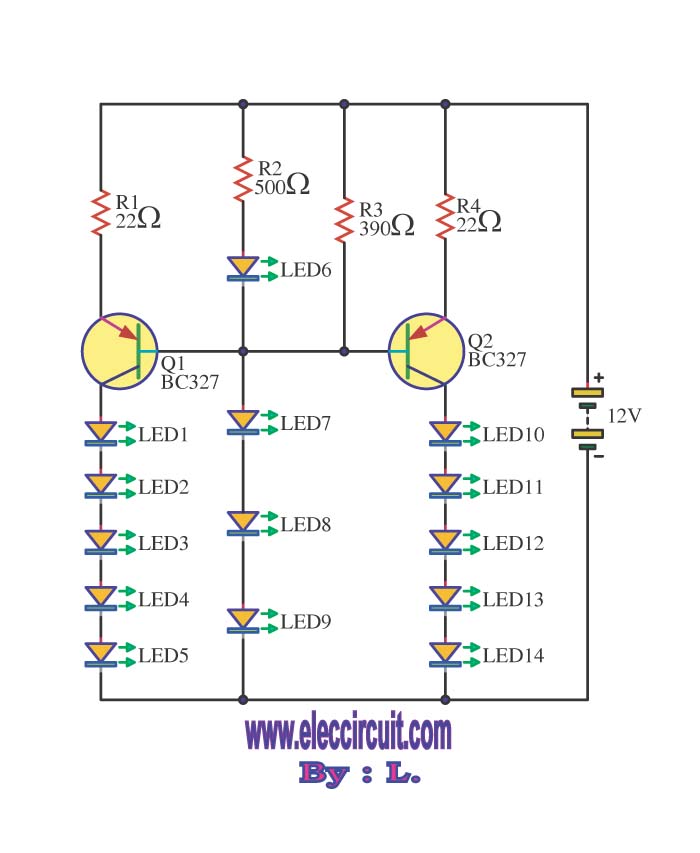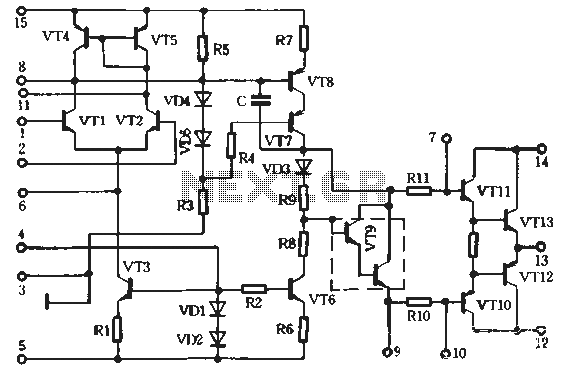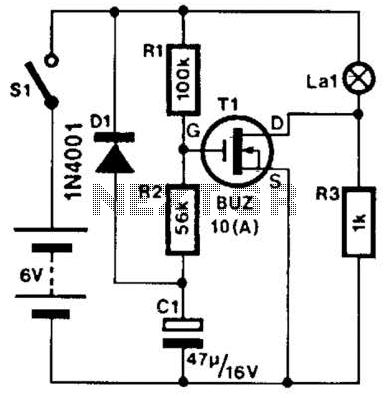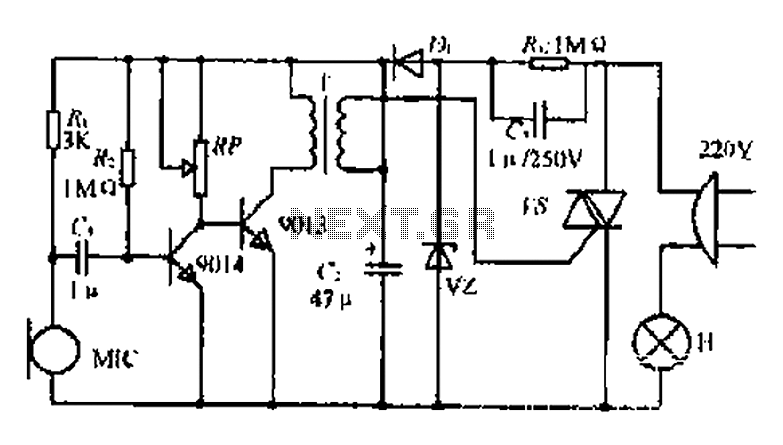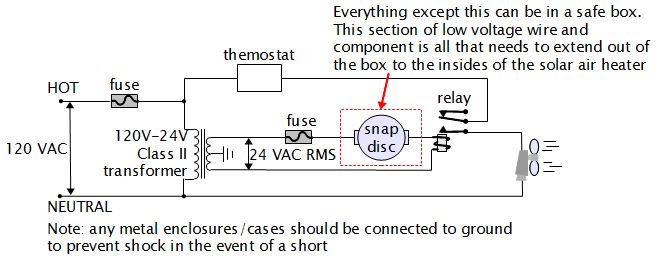
Automatic tracking solar controller circuit
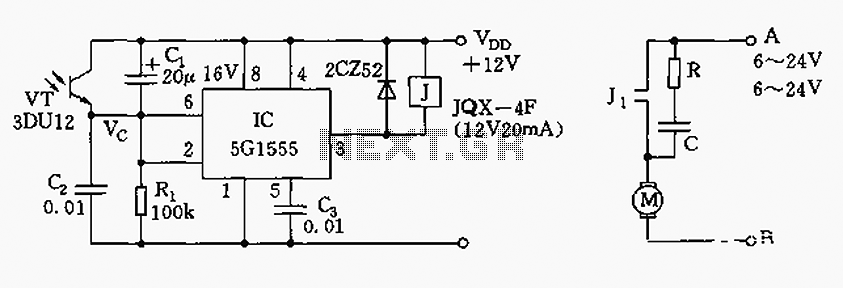
The control circuit consists of an NE555 timer and a phototransistor, along with resistors R1, capacitors C1 and C2, among other components. The photodiodes 3DU12 respond to sunlight by decreasing their resistance, which causes the voltage at the 555 timer to exceed a threshold of 6 feet. When this voltage surpasses 2/3 VDD, the circuit enters a reset state, resulting in a low output level at pin 3, activating relay J. This relay connects to motor M, initiating a slow rotation of the gear. As the motor turns to a specific angle, the illumination on the photodiode diminishes, causing its resistance to increase. Consequently, the charging time of capacitor C1 decreases, leading to a voltage drop at pin 2. When the light level falls below 1/3 VDD, the NE555 timer toggles, and pin 3 outputs a high level ("1"), deactivating relay J and stopping the motor due to loss of power. When sunlight once again illuminates the photodiodes, the motor restarts, enabling a sun-tracking function.
The circuit operates based on the principles of light detection and feedback control. The NE555 timer is configured in a monostable mode, where it monitors the voltage levels at its input pins. The photodiodes 3DU12 serve as light sensors, adjusting their resistance in response to varying light conditions. This change in resistance directly influences the voltage at pin 6 of the NE555 timer, which is critical for determining the operational state of the circuit.
Resistor R1 and capacitor C1 play a vital role in setting the time constants for the charging and discharging cycles, thereby controlling the responsiveness of the motor to light changes. The relay J acts as a switch, allowing the circuit to manage the power supplied to motor M. The motor is designed to rotate slowly, providing precise control over its position, which is essential for effective sun tracking.
The design ensures that the motor only operates when sufficient light is detected, thus conserving energy and preventing unnecessary wear. The feedback mechanism allows the motor to adjust its position in real-time, responding to changes in light intensity detected by the photodiodes. This results in an efficient and reliable sun-tracking system that can be used in various applications, including solar panels and other solar energy devices.As illustrated, the control circuit by the NE555 and phototransistor, R1, C1, C2 and so on. Photodiodes 3DU12 when sunlight to photodiodes, due to its resistance becomes smaller, so that the voltage of the circuit 555 is greater than 6 feet, 6 feet threshold level 2 / 3VDD, the circuit is in the reset state, 3-pin output is low level, the relay J pull, Figure (B), J1 contact connected to the motor M starts to drive slowly rotating gear. Go to a certain angle, photodiode light because it weakened resistance gradually increased, so that the charging time due to C1 potential drop of 2 feet, the light level is below the pin 1 / 3VDD, the flip circuit 555, 3-pin output It showed a high level "1" relay J release, the motor stopped due to power failure, when the sun again illuminated photodiodes, and start the motor, branched sun tracking.
The circuit operates based on the principles of light detection and feedback control. The NE555 timer is configured in a monostable mode, where it monitors the voltage levels at its input pins. The photodiodes 3DU12 serve as light sensors, adjusting their resistance in response to varying light conditions. This change in resistance directly influences the voltage at pin 6 of the NE555 timer, which is critical for determining the operational state of the circuit.
Resistor R1 and capacitor C1 play a vital role in setting the time constants for the charging and discharging cycles, thereby controlling the responsiveness of the motor to light changes. The relay J acts as a switch, allowing the circuit to manage the power supplied to motor M. The motor is designed to rotate slowly, providing precise control over its position, which is essential for effective sun tracking.
The design ensures that the motor only operates when sufficient light is detected, thus conserving energy and preventing unnecessary wear. The feedback mechanism allows the motor to adjust its position in real-time, responding to changes in light intensity detected by the photodiodes. This results in an efficient and reliable sun-tracking system that can be used in various applications, including solar panels and other solar energy devices.As illustrated, the control circuit by the NE555 and phototransistor, R1, C1, C2 and so on. Photodiodes 3DU12 when sunlight to photodiodes, due to its resistance becomes smaller, so that the voltage of the circuit 555 is greater than 6 feet, 6 feet threshold level 2 / 3VDD, the circuit is in the reset state, 3-pin output is low level, the relay J pull, Figure (B), J1 contact connected to the motor M starts to drive slowly rotating gear. Go to a certain angle, photodiode light because it weakened resistance gradually increased, so that the charging time due to C1 potential drop of 2 feet, the light level is below the pin 1 / 3VDD, the flip circuit 555, 3-pin output It showed a high level "1" relay J release, the motor stopped due to power failure, when the sun again illuminated photodiodes, and start the motor, branched sun tracking.
Warning: include(partials/cookie-banner.php): Failed to open stream: Permission denied in /var/www/html/nextgr/view-circuit.php on line 713
Warning: include(): Failed opening 'partials/cookie-banner.php' for inclusion (include_path='.:/usr/share/php') in /var/www/html/nextgr/view-circuit.php on line 713
